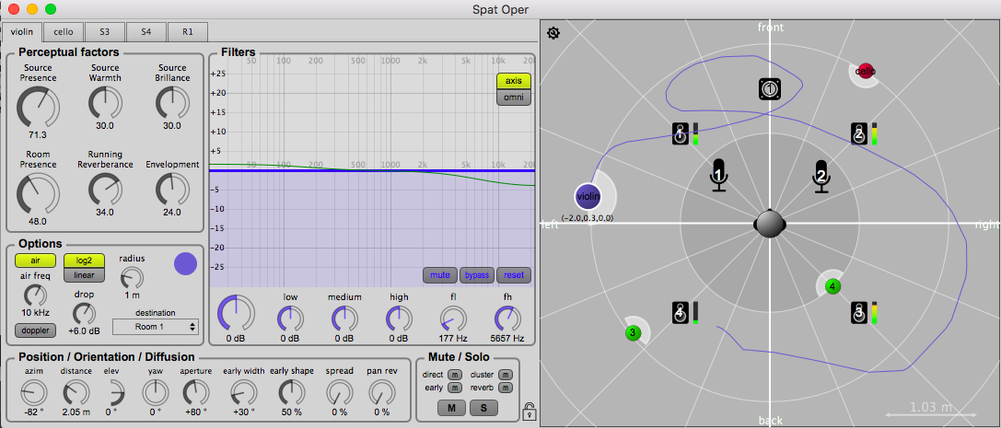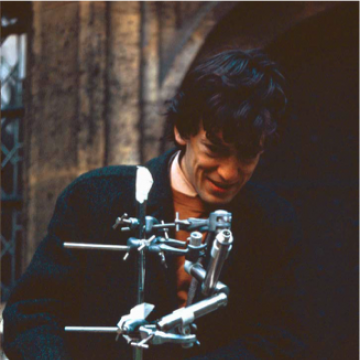There is no such thing as this Audiophool thing called "soundstage".
What term(s) would you use when talking about spatial quality?
Last edited:
There is no such thing as this Audiophool thing called "soundstage".

I certainly would, inc more than 90% of all recordings made.I wouldn't call the best solution for most people most of the time primitive.
There is no such thing as "spatial quality."
That is a nice video. Thank you.
AT 9:24 he combines and ITD and ILD, and explains that we most likely will be hearing his sound coming from the Right channel as ITD wins over ILD generally. For me I was hearing it coming from Left channel. Tried it with 3 headphones, with EQ on and off - all of them still coming from the Left. Anyone had the same effect?
"apparent stage width" (ASW) and "phantom centre"??Would you prefer the terms "apparent stage width" (ASW) and "phantom centre", or do you deny that they exist as well?
"apparent stage width" (ASW) and "phantom centre"??
I don't believe in this.
"apparent stage width" (ASW) and "phantom centre"??
I don't believe in this.
Being as I constructed my own system with 2-3 main criteria, I very much doubt such terms for a proper monitoring system are even close to valid.
The main criteria were:- (FYI)
1/ Almost completely flat response very little attenuation down to 25hz -*from 120hz down...(almost unknown)
Reproduces Albert Hall Organ quite well.
2/ Very careful adjustment and alignment to give an unusually wide neutral listening area. FRONT chs see 2b
(none of this "sweet spot" crap.)
2a/ Front large vertical offset with horn HF drivers - corrected with DSP to prevent driver resonance.
LF units up to 1m lower (physically)than the HF/Mid. (LF is mostly non directional)
2b/ Omni rear surround speakers with wide range drivers 1m+ above listener - leading to wide rear non directional ambience.
3/ Multi channel recording LIVE or using stereo signals to feed F +R systems at correct surround ratio.
"apparent stage width" (ASW) and "phantom centre"?
NONE OF ABOVE.
The so called stage width doesn't exist- it fills the room.
I don't use a centre channel.
To me this "sound stage" nonsense comes from poor room nodes and cancellation/subtraction at multiple frequencies.
(we don't need / want directional info being beamed at a listener)
+
a) The ability to confuse people with masking effects is clearly proveable.*
The inability of easily 70-80% of listeners to distinguish at blind test between high rate MP3 (with masking artefacts) and real high bit depth PCM from proper live material.. (Shocking but true)
The "Brainwash effect" of people constantly listening to processed digital music in the last 2 decades.
b/ Conditioning responses.
c/ Comb filtering of FR in people that have been conditioned this way.
eg. heard of "autotune"? Fake voices, fake intonation.
I remain highly dubious of any of the so called "high end" systems I ever auditioned.
These were usually in extremely sub optimal listening environments.
They failed convince me ever, that the whole thing was anything other than a big pile of BS.
Why do your own thing this way?
If you can't get anyone else to do a job properly - DO IT YOURSELF.
sub woofer tech is a can of worms, and handling LF [properly & cleanly, with good integration) requires maximum RMS power, + proper treatment.
NB.
Headphones (cans!) were no better - imaging behind the ear.
You may not agree, but plenty research evidence on this.
Perhaps some of the best recordings done were binaural with dummy head. (Bruel & Kjaer mics)
Make of that what you can.
There is no such thing as "spatial quality."
You are listening to transducers exciting the acoustic of your room.
The so called stage width doesn't exist- it fills the room.
Can you elaborate on what you are doing and how it results in "an usually wide neutral listening area"? (I'm not challenging your claim; I'm interested in learning what you are doing.)2/ Very careful adjustment and alignment to give an unusually wide neutral listening area. FRONT chs see 2b
(none of this "sweet spot" crap.)
So if I understand correctly, your horns are up fairly high and the low frequency section is very close to the floor? I can think of at least one good reason do to that. I would be interested in any details about the configuration, radiation patterns, crossover frequencies, whatever, that you are willing to share.2a/ Front large vertical offset with horn HF drivers - corrected with DSP to prevent driver resonance.
LF units up to 1m lower (physically)than the HF/Mid. (LF is mostly non directional)
We do this on the OTHER end. (occasionally)I don't understand what processing they are doing, only that it has something to do with crosstalk cancellation, but it definitely works.
sorry but this post is full of contradictions and an oxymoron...ie. hoping to do what Avery Fisher tried.Stereo can reproduce via loudspeakers playback the soundstage and imaging accurately but only under limited conditions.
R1) the microphone should capture the exact ITD and ITD.
R2) the reproduction should be with exact placement of speakers as the original event.
R3) room acoustics that can reproduce the reverbs.
R1 can be achieved with binaural recording. Better still if the dummy head and torso are the replica of the listener.
The problems:-
P1) the sound captured by the microphone is not the same that is coming out from the speakers due to HRTF modification. This can sound accurate if played via headphones but not with loudspeakers as it requires correction filter to be applied.
why ignore Binaural and dummy head recording?There are other problems with binaural headphones playback but I will skip that for now
So realism suffers s.... stereo soundstage after years of listening to them somehow learnt to overlook those errors. Those listening with headphones for ears not conscious or bothered about inside the head soundstage.
We adapt to sound and learned to overlook the imperfection.
P2/3 is the inherent problem with stereo playback because it produces a duplicate sound delayed by about 220 μs to the wrong ear which is known as interaural crosstalk. So no matter what you do your soundstage width is confined to the maximum ITD difference position of the crosstalk. The real need is for a soundstage that is more believable and natural rather than accurate reproduction of the soundstage. The goal of good stereo playback is to reproduce natural and live experience. Accurate reproduction via stereo is impossible without your HRTF used in the recording of the real event And that too will be limited to the frontal stage with limited lateral information.
I already said there is no such thing as "soundstage".
sorry but this post is full of contradictions and an oxymoron...ie. hoping to do what Avery Fisher tried.
Confuse the audience and blind testing live v recorded music in his concert hall (ie. it's all been done properly before).
why ignore Binaural and dummy head recording?
The BBC tried it LIVE on Radio 3 years ago. (with of course mixed results) same as the results broadcasting
The Tempest by shakespeare in Matrix H surround btw....
I already said there is no such thing as "soundstage".
You just proved the exact reverse of most of the points you set out to discuss, by comparing headphones and binaural with reality (they are NOT REAL, and has nothing to do with HRTF).
They are merely a different representation of reality from speakers.
Headphones are worse than hopeless for audio editing, no matter the price, but most broadcast engineers are using precisely this failed listening strategy, and hoping the final result is presentable.*
How do you expect to have listenable recordings this way when everything in the entire chain is either fake or artificial??
It's an invention of all those blingy audiophool marketing and glossy magazines.
The same people that claim they can hear extra details by changing speaker wire!
*One of my references is Janszen.
His father invented the ESL....Walker just copied some of the ideas.
I guess you are trying to say something important but I can’t figure out what it supposed to be.
Just because you said so it doesn’t stop to exist. Almost every discussion about stereo refers to the two terms.
I guess you are trying to say something important but I can’t figure out what it supposed to be.
Quite possibly because you have never been involved in the entire chain from Live recording to Broadcast audio + validation of a reproduction system.It's like he wants something undefined to be undefined differently. All I get from it is a headache.

It is even possible to argue the meaning of existence. But in this case I would guess that the term of "soundstage" is something adopted by the audiophiles to describe the imaginary 3D space created by 2 channel stereo within listening environment.
Thanks for your excellent post which did better than I can to explain the issues.
I suspect I get something like this, as I took a lot of trouble measuring my system..... which is why I opted for (Russian made) horns quite similar to the highly regarded 288G. (Lomo)
"dispersion characteristics no wider than 60 degrees, with a toe in angle of setup along which you get flat DI along the listening axis and not too much energy reflected to the sidewalls."
It took ages to get this system right.
Tolerances are to the order of mere cm, and +/- a few degrees on the mid ranges and the horns.
I was suprised just how difficult it was to set up and calibrate correctly, then measure using my Neumanns and Calrecs parallelled to cancel out any effects. (one is wide omni, the other cardio, both with known parameters)
"Low frequencies are very important, so do what you can with your subs"...
I don't have subs I have 1 x12" and 1x 15" in a giant sized cab x 2 channels (235L x 2) to handle anything down to 18hz, with deliberately no rolloff at all (nearly all systems have a 10dB per octave drop below 100hz).
And yes the entire front system is handled by 2 whopping great vintage valve amps. from 1963-64.
The acquistion sound card also has to be a known quantity.
(we found the same sound card behaved differently when run under Linux 32 compared with win32 - ouch!)
